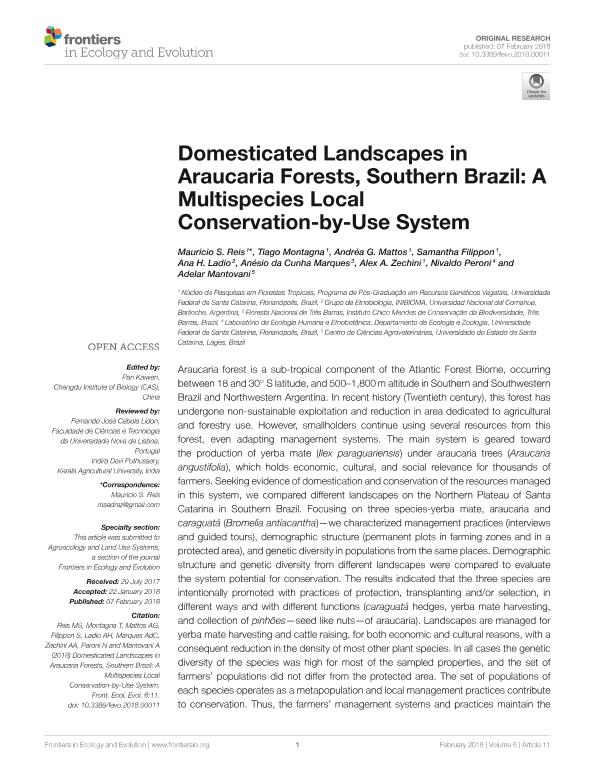Artículo
Domesticated landscapes in araucaria forests, southern Brazil: A multispecies local conservation-by-use system
Sedrez Dos Reis, Maurício; Montagna, Tiago; Mattos, Andréa G.; Filippon, Samantha; Ladio, Ana Haydee ; da Cunha Marques, Anésio; Zechini, Alex A.; Peroni, Nivaldo; Mantovani, Adelar
; da Cunha Marques, Anésio; Zechini, Alex A.; Peroni, Nivaldo; Mantovani, Adelar
 ; da Cunha Marques, Anésio; Zechini, Alex A.; Peroni, Nivaldo; Mantovani, Adelar
; da Cunha Marques, Anésio; Zechini, Alex A.; Peroni, Nivaldo; Mantovani, Adelar
Fecha de publicación:
07/02/2018
Editorial:
Frontiers Media SA
Revista:
Frontiers in Ecology and Evolution
ISSN:
2296-701X
Idioma:
Inglés
Tipo de recurso:
Artículo publicado
Clasificación temática:
Resumen
Araucaria forest is a sub-tropical component of the Atlantic Forest Biome, occurring between 18 and 30° S latitude, and 500-1,800 m altitude in Southern and Southwestern Brazil and Northwestern Argentina. In recent history (Twentieth century), this forest has undergone non-sustainable exploitation and reduction in area dedicated to agricultural and forestry use. However, smallholders continue using several resources from this forest, even adapting management systems. The main system is geared toward the production of yerba mate (Ilex paraguariensis) under araucaria trees (Araucaria angustifolia), which holds economic, cultural, and social relevance for thousands of farmers. Seeking evidence of domestication and conservation of the resources managed in this system, we compared different landscapes on the Northern Plateau of Santa Catarina in Southern Brazil. Focusing on three species-yerba mate, araucaria and caraguatá (Bromelia antiacantha)-we characterized management practices (interviews and guided tours), demographic structure (permanent plots in farming zones and in a protected area), and genetic diversity in populations from the same places. Demographic structure and genetic diversity from different landscapes were compared to evaluate the system potential for conservation. The results indicated that the three species are intentionally promoted with practices of protection, transplanting and/or selection, in different ways and with different functions (caraguatá hedges, yerba mate harvesting, and collection of pinhões-seed like nuts-of araucaria). Landscapes are managed for yerba mate harvesting and cattle raising, for both economic and cultural reasons, with a consequent reduction in the density of most other plant species. In all cases the genetic diversity of the species was high for most of the sampled properties, and the set of farmers' populations did not differ from the protected area. The set of populations of each species operates as a metapopulation and local management practices contribute to conservation. Thus, the farmers' management systems and practices maintain the landscape with productive forest fragments, favoring the conservation-by-use of these species. The system requires these management practices, which bring about changes in various species and are motivated by cultural and economic factors, in order to maintain the landscapes domesticated.
Archivos asociados
Licencia
Identificadores
Colecciones
Articulos(INIBIOMA)
Articulos de INST. DE INVEST.EN BIODIVERSIDAD Y MEDIOAMBIENTE
Articulos de INST. DE INVEST.EN BIODIVERSIDAD Y MEDIOAMBIENTE
Citación
Sedrez Dos Reis, Maurício; Montagna, Tiago; Mattos, Andréa G.; Filippon, Samantha; Ladio, Ana Haydee; et al.; Domesticated landscapes in araucaria forests, southern Brazil: A multispecies local conservation-by-use system; Frontiers Media SA; Frontiers in Ecology and Evolution; 6; 11; 7-2-2018; 1-14
Compartir
Altmétricas



